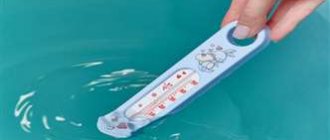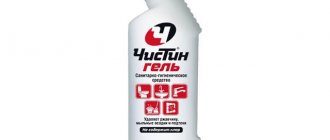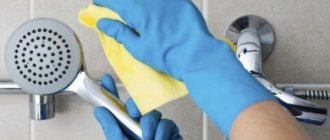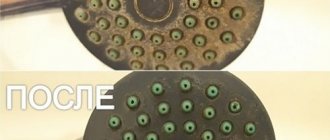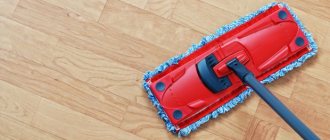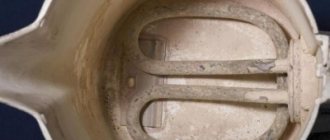The bathroom mirror quickly loses its flawless appearance as it becomes covered with limescale, dried splashes and water stains. Looking at it becomes not only unpleasant, but also pointless. The reflection will still be distorted. This is due to too hard water that flows in many regions. And if the housewife is not very careful and cleans the mirrors from time to time, limescale deposits can become permanently attached to them. Therefore, you need to care for mirrors not only in a timely manner, but also correctly.
How to clean a bathroom mirror
Before removing limescale, you need to wash the mirror with a sponge soaked in a soapy solution.
During cleaning, you can use commercial chemical cleaners or homemade ones you prepare yourself. Before using them, it is important to prepare the glass and wash it with a sponge soaked in soapy water. Remove residues and stains with a microfiber cloth.
Chemicals
To clean a mirror from limescale, choose liquid substances that will not damage the surface of the glass.
For light contamination, it is enough to apply the product for 2-3 minutes to remove water stone. For more complex stains, it will take 10-15 minutes. But these are general rules. To avoid mistakes, read the instructions for the product. It should tell in detail about the method of cleaning the bathroom mirror from limescale and the time of action of the chemical.
The most well-known and effective glass cleaners are produced under the following brands:
- Alcohol-based Cif
- Cillit with oxalic acid, created specifically for removing water scale on any surface;
- Clin with isopropyl alcohol;
- Mr Muscle with ammonia;
- Frosch Glass Cleaner contains only natural ingredients;
- Eco-spray Organic People contains essential oils;
- Spectrum-Profi is based on isopropyl alcohol with an antistatic effect.
Among household chemicals, any fabric softener, which is added in small quantities to the water for washing the mirror, will help cope with dirt and limescale.
A dishwasher detergent designed for glass food products will help you clean your mirror with a 100% guarantee. Car cleaner will also work.
Use rubber gloves to wash surfaces with acids and household chemicals. This will help prevent damage to the skin and maintain its attractiveness. All work must be carried out in a well-ventilated area or artificial ventilation must be created using a hood. If you adhere to this condition, you can prevent poisoning by chemical compounds.
Before cleaning the mirror, you should read the instructions for use and the expiration date of the product. Unsuitable or expired detergent will not help clean the mirror and will lead to defects.
Folk remedies
Effective folk remedies for limescale deposits on mirrors
You can remove water stone from a mirror surface by preparing one of the following compositions:
- With acetic acid. Mix 5 ml of vinegar essence with boiled warm water. Using a soft sponge or cloth, apply the product to the mirror and rinse off after 10-15 minutes with running water.
- With ammonia. Mix 200 ml of warm water and 2 tbsp. l. 10% ammonia solution. Apply for half an hour to the areas that need to be cleaned. Ammonia can be replaced with regular vodka or other alcohol-containing products, such as cologne.
- With citric acid. Dissolve a packet of powder in 200-250 ml of water, about 15-20 g. Apply to a mirror surface for 15 minutes. You can replace citric acid with citrus fruit juice.
- With baking soda. 5 tbsp. l. pour soda with a small amount of water until a paste forms. Apply the product to the mirror for 20-30 minutes. However, you should be careful when using this method, as particles of soda can scratch the surface, which will lead to damage to the mirror.
- With potatoes . Rub the glass with peeled vegetables and rinse it.
- With vinegar and chalk. Dilute 1 tbsp in warm water. l. vinegar and chalk. Stir thoroughly and set aside. Drain the liquid and use the lime to clean the mirror. Remove the solution with purified water.
- With starch. Dilute 20 g of powder in 1 liter of boiled water. Wash the glass with the resulting composition using a foam cloth. No additional polishing is required.
Folk recipes will help out when you don’t have suitable household chemicals at hand. They are easy to prepare and use.
What will manufacturers of household chemicals please you with?
Stores sell many different products for all surfaces. It is important to understand that powders are not always suitable because they contain abrasive particles. Among the windshield wipers, there are those that cope with any dirt without scratching the surface. “Mister Muscle”, “Sif”, “Silit-gel”, “Second” have especially proven themselves. In order for the deposit to dissolve, the sprayed glass cleaner should not be washed off immediately, but after 15-20 minutes.
Since all chemicals that can dissolve limescale are quite aggressive, you cannot work with them without gloves. If this product gets on your skin, wash it off immediately with water. Well, in order to use them as little as possible, the mirror needs to be wiped dry every time moisture appears on it.
Washing tools
Various tools will help make the job of cleaning a mirror easier.
Steam generators
A steam vacuum cleaner will quickly remove any dirt from the bathroom mirror.
For cleaning, you can use devices that supply a hot stream of steam under pressure: a steam vacuum cleaner, a steam generator or a steam cleaner. The peculiarity of such devices is that they help to effectively remove contaminants even in the most inaccessible places and destroy pathogenic microorganisms that cause many diseases.
When working with a steam generator, you do not need to wear gloves, and it is enough to remove stains with a household rag.
If the stain cannot be removed the first time, apply a vinegar solution to the glass, and then go over the mirror again with a steam cleaner.
Melamine sponge
This is a universal product made from melamine fibers. The substance resembles plastic, like school eraser. Suitable for cleaning the surface of mirrors, stoves, and plumbing fixtures from any contaminants without the use of additional preparations.
To remove water stone, just wet the sponge, which will create foam, and wipe the glass. Upon contact with dirt, the melamine sponge begins to crumble. For repeated use, it is recommended to cut it into several parts.
Melamine is a toxic compound that, if ingested, leads to intoxication. Therefore, after using such a sponge, you need to wash your hands thoroughly.
Video material
By forgetting to take care of your mirrors, you are putting problems on the back burner. In addition to the main interior, do not forget about the glass, because dirty glass will look ugly against the backdrop of a perfectly clean apartment. And who wants to spend too much time on something if, with proper care, it will still last a sufficient amount of time. The most important thing is to remember that this needs to be done cyclically, and by using all these simple methods, you will achieve the perfect reflection in the glass.
How to make a mirror shine
After cleaning the mirror surface, you can polish it using strong tea : 1 tbsp. l. Pour boiling water over the tea leaves and leave for half an hour. Add 5 g of salt, stir thoroughly. Polish the mirror with a microfiber cloth soaked in the resulting mixture.
Glycerin , a weak solution of bluing or milk will help to cope with stains : apply to the glass and rub with a cloth.
The shine of the glass will help return linseed oil . Rub the surface with a woolen cloth until the greasy layer is removed.
You can polish the surface until it shines with a peeled onion : rub and leave for 10 minutes. Rinse with water. This method helps to add shine to the mirror and prevent insects from settling.
An effective remedy against stains is ammonia . Dilute in water in a ratio of 1:5 and spray on a mirror surface. Wipe the glass until it shines with a cotton or microfiber cloth.
You can wash a mirror without streaks if, at the final stage of cleaning, you polish the surface with damp nylon tights, newspaper or a special napkin for cleaning office equipment. The latter are impregnated with an antistatic agent, which prevents dust from settling on the surface.
Basic cleaning steps
Mirrors require regular care, and in high humidity conditions this is especially important.
Cleaning reflective surfaces consists of three stages: removing dust and large stains, getting rid of streaks and obtaining shine.
Preparing the mirror for cleaning
Depending on the condition and area of contamination, different cleaning options are used.
If the surface is wet, remove all water first. A paper towel, lint-free cloth or microfiber is suitable for this.
For large stains, apply the cleaner and allow it to thoroughly absorb the stains. If this doesn't help, try gently scraping them off with a razor blade or sharp knife.
Cleaning the mirror surface
After removing the main contaminants, remove any remaining detergent and dirt, as well as stains.
To do this, rinse the mirror with clean water and wipe with a damp sponge or microfiber. To get the best result, use boiled and settled liquid. Don't forget to rinse the sponge periodically.
Removing liquid and adding shine
After removing the remaining household chemicals, remove moisture from the surface using microfiber. Then treat the mirror with special compounds to obtain shine.
Prevention of plaque
A water filter will make it softer, and then limestone will not appear.
The source of limescale is hard water. You can prevent its formation on the glass surface by eliminating splashes. To do this, place the mirror away from the shower or bathtub. After each shower, remove liquid from the glass with a dry cloth.
It is better to care for the surface using clean boiled or settled water. High temperatures will help get rid of excess salts in the liquid.
To purify and soften water, you can install special filters at home. Then limestone will appear much less frequently.
Moisture is the main enemy of mirrors
Firstly, the same limescale deposits appear on them. Secondly, the amalgam deteriorates, begins to warp, and lag behind. Thirdly, a wet mirror is not capable of reflecting objects reliably. Therefore, you need to choose the right place for the mirror.
- There should be no tap or shower nearby, as water splashes all around.
- Before placing it on the wall, lubricate the back wall of the amalgam mirror with a mixture of 2 parts turpentine and 1 part melted wax.
- To prevent the amalgam from peeling off, you need to cover its perimeter with plastic tape or cover the entire back of the mirror with oil paint.


